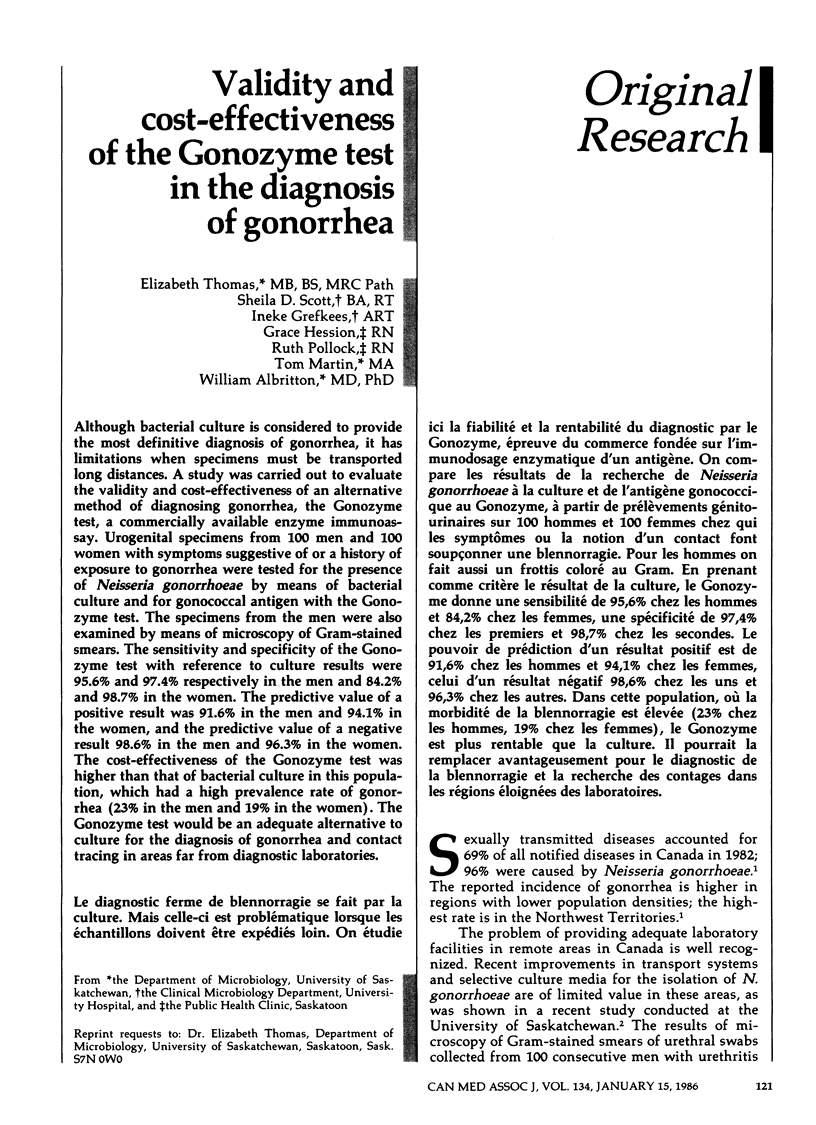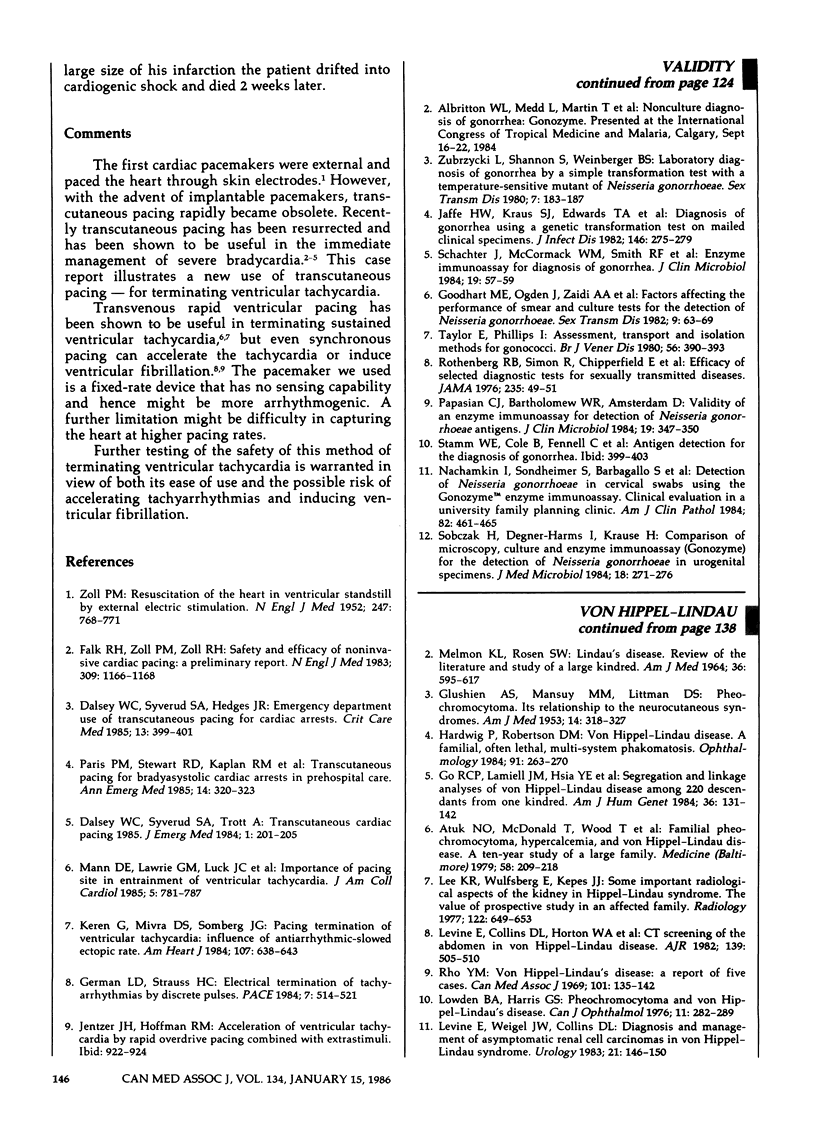Abstract
Although bacterial culture is considered to provide the most definitive diagnosis of gonorrhea, it has limitations when specimens must be transported long distances. A study was carried out to evaluate the validity and cost-effectiveness of an alternative method of diagnosing gonorrhea, the Gonozyme test, a commercially available enzyme immunoassay. Urogenital specimens from 100 men and 100 women with symptoms suggestive of or a history of exposure to gonorrhea were tested for the presence of Neisseria gonorrhoeae by means of bacterial culture and for gonococcal antigen with the Gonozyme test. The specimens from the men were also examined by means of microscopy of Gram-stained smears. The sensitivity and specificity of the Gonozyme test with reference to culture results were 95.6% and 97.4% respectively in the men and 84.2% and 98.7% in the women. The predictive value of a positive result was 91.6% in the men and 94.1% in the women, and the predictive value of a negative result 98.6% in the men and 96.3% in the women. The cost-effectiveness of the Gonozyme test was higher than that of bacterial culture in this population, which had a high prevalence rate of gonorrhea (23% in the men and 19% in the women). The Gonozyme test would be an adequate alternative to culture for the diagnosis of gonorrhea and contact tracing in areas far from diagnostic laboratories.
Full text
PDF




Selected References
These references are in PubMed. This may not be the complete list of references from this article.
- Goodhart M. E., Ogden J., Zaidi A. A., Kraus S. J. Factors affecting the performance of smear and culture tests for the detection of Neisseria gonorrhoeae. Sex Transm Dis. 1982 Apr-Jun;9(2):63–69. doi: 10.1097/00007435-198204000-00002. [DOI] [PubMed] [Google Scholar]
- Jaffe H. W., Kraus S. J., Edwards T. A., Weinberger S. S., Zubrzycki L. Diagnosis of gonorrhea using a genetic transformation test on mailed clinical specimens. J Infect Dis. 1982 Aug;146(2):275–279. doi: 10.1093/infdis/146.2.275. [DOI] [PubMed] [Google Scholar]
- Nachamkin I., Sondheimer S. J., Barbagallo S., Barth S. Detection of Neisseria gonorrhoeae in cervical swabs using the Gonozyme enzyme immunoassay. Clinical evaluation in a university family planning clinic. Am J Clin Pathol. 1984 Oct;82(4):461–465. doi: 10.1093/ajcp/82.4.461. [DOI] [PubMed] [Google Scholar]
- Papasian C. J., Bartholomew W. R., Amsterdam D. Validity of an enzyme immunoassay for detection of Neisseria gonorrhoeae antigens. J Clin Microbiol. 1984 Mar;19(3):347–350. doi: 10.1128/jcm.19.3.347-350.1984. [DOI] [PMC free article] [PubMed] [Google Scholar]
- Rothenberg R. B., Simon R., Chipperfield E., Catterall R. D. Efficacy of selected diagnostic tests for sexually transmitted diseases. JAMA. 1976 Jan 5;235(1):49–51. [PubMed] [Google Scholar]
- Schachter J., McCormack W. M., Smith R. F., Parks R. M., Bailey R., Ohlin A. C. Enzyme immunoassay for diagnosis of gonorrhea. J Clin Microbiol. 1984 Jan;19(1):57–59. doi: 10.1128/jcm.19.1.57-59.1984. [DOI] [PMC free article] [PubMed] [Google Scholar]
- Sobczak H., Degner-Harms I., Krause H. Comparison of microscopy, culture and enzyme immunoassay (Gonozyme) for the detection of Neisseria gonorrhoeae in urogenital specimens. J Med Microbiol. 1984 Oct;18(2):271–276. doi: 10.1099/00222615-18-2-271. [DOI] [PubMed] [Google Scholar]
- Taylor E., Phillips I. Assessment of transport and isolation methods for gonococci. Br J Vener Dis. 1980 Dec;56(6):390–393. doi: 10.1136/sti.56.6.390. [DOI] [PMC free article] [PubMed] [Google Scholar]
- Zubrzycki L., Weinberger S. S. Laboratory diagnosis of gonorrhea by a simple transformation test with a temperature-sensitive mutant of Neisseria gonorrhoeae. Sex Transm Dis. 1980 Oct-Dec;7(4):183–187. doi: 10.1097/00007435-198010000-00008. [DOI] [PubMed] [Google Scholar]


